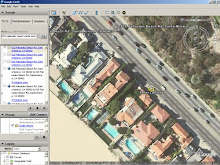How to View Satellite Image of your House
View satellite image of your house with the free version ofearth explorer.You can view or save satellite images and driving direction and ofcourse aerial maps.You can zoom in from space to the street level with just point and click of the mouse,activate terrain,3d buildings,road maps etc.it also includes a separate world maps whichis also capable of zooming to the street level.You can download it here
SATELLITE IMAGES :USES
Satellite images have many applications in agriculture, geology, forestry, biodiversity conservation, regional planning, education, intelligence and warfare. Images can be in visible colours and in other spectra. There are also elevation maps, usually made by radar imaging. Interpretation and analysis of satellite imagery is conducted using software packages like ERDAS Imagine or ENVI. Some of the first image enhancement of satellite photos was conducted by the U.S. Government and itscontractors. For example ESL Incorporated developed some of the earliest two dimensional Fouriertransforms applied to digital image processing to address NASA photos as well as national security applications.Resolution and data
The resolution of satellite images varies depending on the instrument used and the altitude of the satellite's orbit. For example, the Landsat archive offers repeated imagery at 30 meterresolution for the planet, but most of it has not been processed from the raw data. Landsat 7 has an average return period of 16 days. For many smaller areas, images with resolution as high as 10 cm can be available. DigitalGlobe's WorldView-1 satellite provides the world's highest resolution commercial satellite imagery[1]. The 50 cm resolution of WorldView-1's panchromatic images allows the satellite to distinguish between objects on the ground that are at least 50 cm apart. Similarly DigitalGlobe's QuickBird satellite provides 2.4 meter resolution multispectral images.Satellite imagery is sometimes supplemented with aerial photography, which has higher resolution,but is more expensive per square meter. Satellite imagery can be combined with vector or raster data in a GIS provided that the imagery has been spatially rectified so that it will properly align with other data sets.
Moving images
In 2005 the Australian company Astrovision (ASX: HZG) announced plans to launch the first commercial geostationary satellite in the Asia-Pacific. It intended to provide true color, real-time live satellite feeds, with down to 250 metres resolution over the entire Asia-Pacific region, from India to Hawaii and Japan to Australia. They were going to provide this content to users of 3G mobile phones, over Pay TV as a weather channel, and to corporate and government users.
Unfortunately, the market response to the AstroVision concept fell into the classic chicken-egg problem: potential customers were excited by the possibilities offered, but they were unwilling (or, in government cases, generally unable) to sign contracts for a service that would not be delivered for 3-4 years (the length of time required to build and launch the satellite). AstroVision ran low on funds and was forced to shut down the program in 2006.
